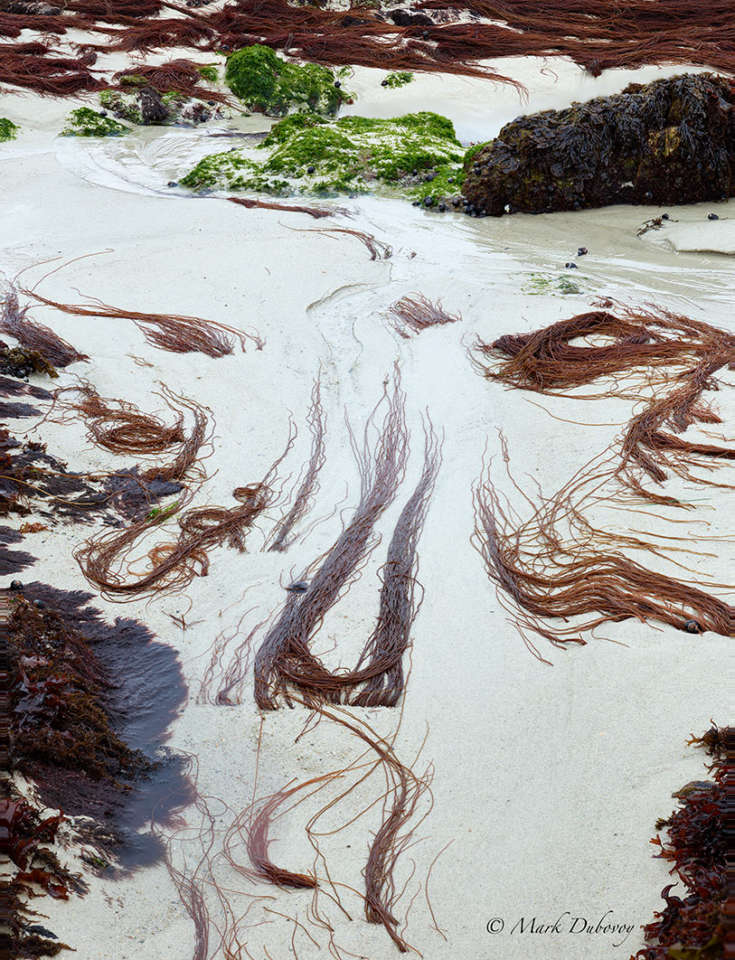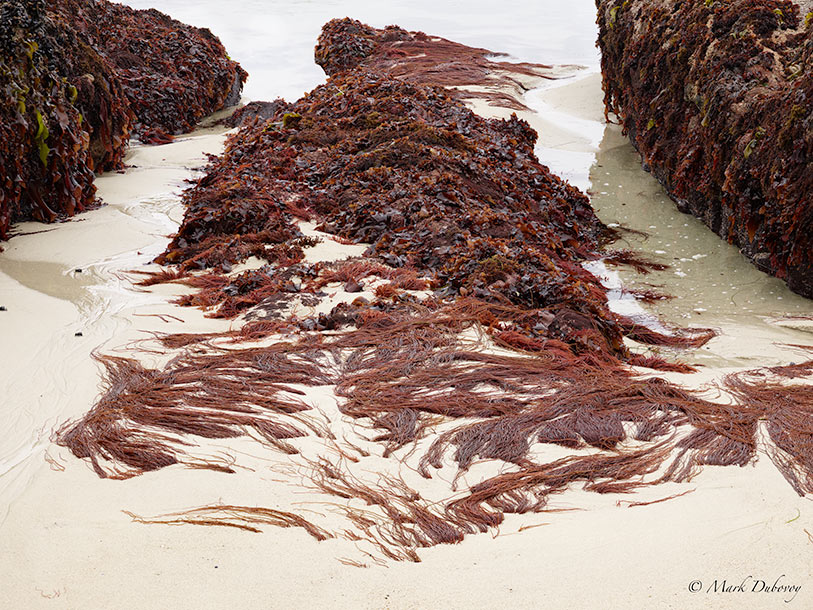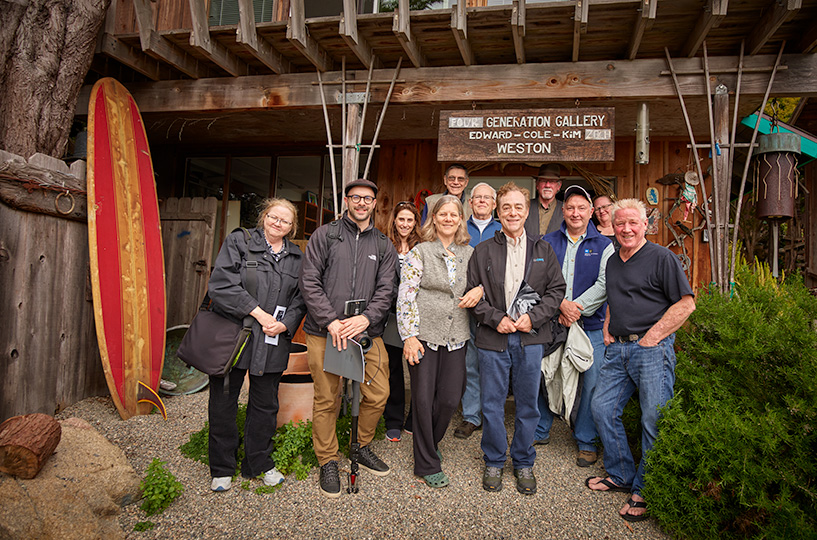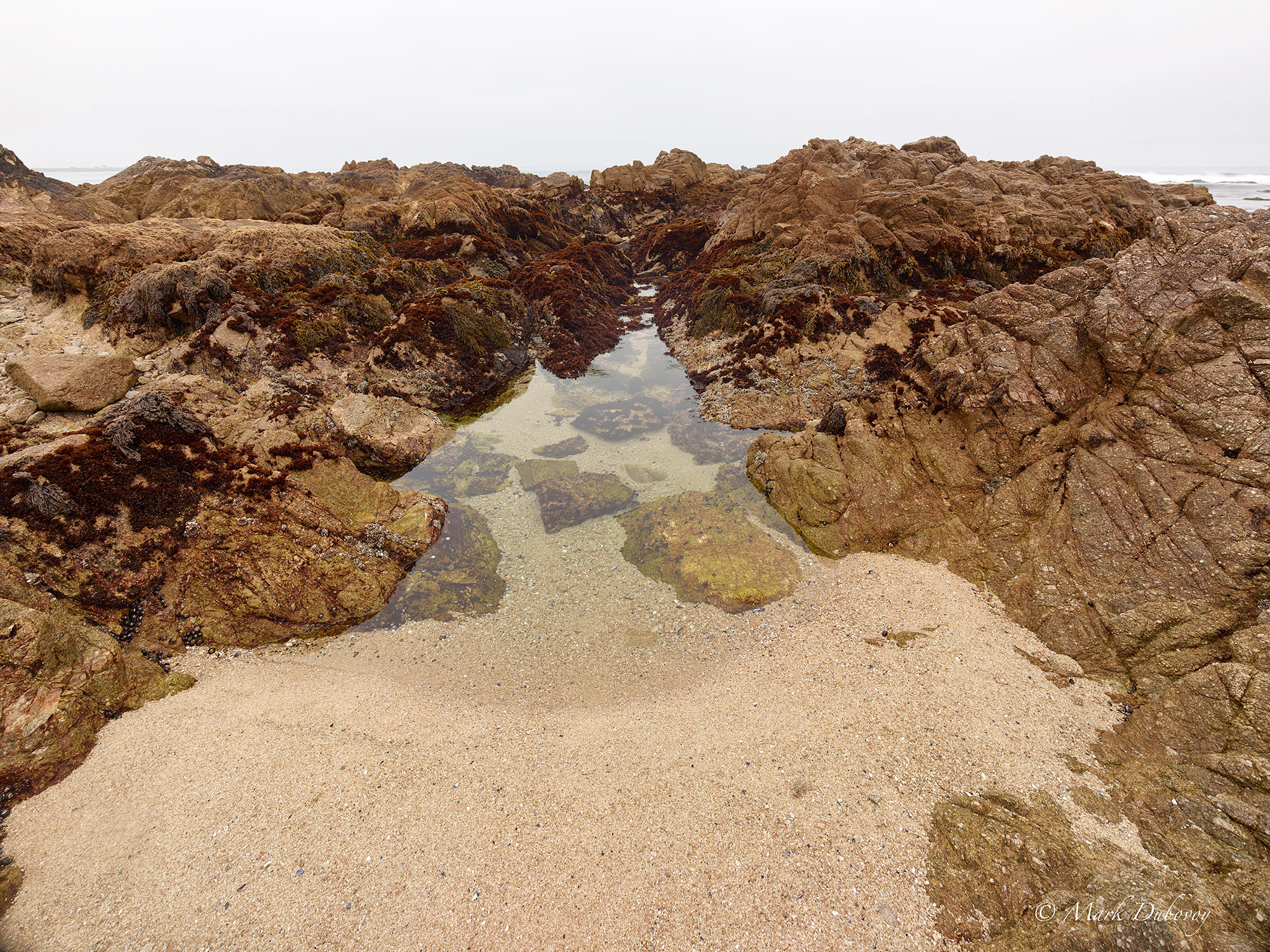Introduction
It was a foggy morning at Asilomar. We convened around 6 AM at the beach, just after first light. After a little scouting around, I found a scene with water and rocks that to me expressed quiet and tranquility. The phrase “Quiet Rocks” kept going through my mind.
It was a scene that required very careful camera positioning and extreme depth of field. While the temptation was there to use an SLR camera and do a focus composite of several images, I felt it was crucial to show just a little bit of the ocean in the horizon. The moving water near the horizon made the choice of a focus composite sub-optimal, so I immediately thought of using a technical or a view camera with front tilt.
Upon studying the scene further, it became apparent that I was going to need an extreme wide angle lens. So I decided to use the Cambo WRS-5000 technical camera with the 23mm Rodenstock HR Distagon lens. This most extreme of wide angle lenses for Medium Format gives a wonderful engulfing look and invites the viewer into the image. One of the attributes of this lens, is its extraordinary depth of field. It can render objects from about 4 Feet to infinity with extreme sharpness at F/11.
Therefore, I did not need to shoot a focus stack, as we had been doing so often during this workshop. And the lens choice was such that tilt was not required either. The technical camera was the right tool, as a lens this wide is not available for Medium Format SLR’s.
The result is the main image in this article. While subtle, I believe that the details in the horizon and the sky are crucial to this image. Without them, the context is lost and the image becomes confusing.
This was a typical situation during the photographic workshop sponsored by PhotoAesthetics on the West Coast last May. The instructors were Jim Taskett and myself and the emphasis was on making superior images and using the proper tools and techniques for each image.
Location
Picking the right location for a workshop is always difficult. There are many parameters to consider, such as the weather, accessibility to travelers from afar, accommodations, ease or difficulty to get to the key places where photographic opportunities abound, etc.
Jim and I chose Asilomar as the headquarters for the workshop. Asilomar specializes in groups and conventions and is located in a very convenient area with a wonderful beach that is a short walk from the rooms and a short drive to Carmel and Monterey with all the beautiful areas surrounding those two wonderful towns.
I would describe the accommodations at Asilomar as adequate, but certainly not luxurious.
Objective
Our objective was to make the workshop a true learning experience as well as a way to make new friends and build some camaraderie. We also wanted to focus the workshop on the usage of the most powerful tools available in order to produce superior images.
We made it a point to bring a variety of high end tools that the photographers taking the workshop could use. These included a number of digital backs, Medium format SLR bodies, technical cameras and a view camera. The workshop participants were able to learn and to use these cameras in a variety of situations.
We kept the group small on purpose so that the participants would get plenty of one on one time with the instructors.
Besides the field work, we also spent a fair amount of time on lectures and discussions about the art of photography, image creation, do’s and dont’s, the craft itself, software such as PhaseOne CaptureOne and Adobe Photoshop, preparing files for printing and making prints.
Field sessions
Most of the field sessions were held at the beach in Asilomar and at Point Lobos.
We had one extremely lucky day at Point Lobos. We arrived right after opening time as a rain storm was coming to an end. The light was beautiful.
There were no other visitors to the park, probably because of the rain. I believe we had the entire place to ourselves for about 3.5 hours! We were able to see many harbor seals, sea otters, several grey whales, a huge group of dolphins and large numbers of pelicans and crabs. Many other birds were mating at the time, so Bird Rock was quite a spectacle. I have never seen Point Lobos like this before. To say that it was teeming with life is an understatement.
Being able to shoot at Weston Beach without anyone else around was an amazing treat.

Sand and Kelp 1.
PhaseOne XF Focus Stack with 55 mm PhaseOne/Schneider Blue line lens and IQ3-100 back
A big leap forward
Photography tools have recently taken a major leap in terms of features, usability, ergonomics and more importantly image quality. This goes for cameras, lenses and printers, as well as software products such as RAW converters and editing software.
As our readers know well, we only review equipment or software that we use extensively and feel is the highest quality equipment available for our type of photography.
More details on all these devices are forthcoming in a series of future articles. Suffice it to say for now that in the past 6-9 months there have been major leaps in quality in digital backs, camera bodies, lenses, printers and software.
Most popular
The most popular camera and the most used feature by the workshop participants was the PhaseOne XF system using Focus Stacking. For those of you who are not familiar with focus stacking, this technique consists of taking several shots focusing the lens at different distances in each shot. Then, one can merge these images to produce a final combined image with much larger depth of field. The PhaseOne XF camera has a beautiful interface to automatically shoot a Focus Stack. The photographer needs to choose the closest and the farthest focus points as well as the number of shots. The camera does the rest automatically. The images are then processed and merged (preferably) using Helicon Focus.
The two images interleaved with the text in this article are focus stack composites, while the main image in the article was captured with a CAMBO Pro WRS-5000 field camera and a Rodenstock 23 mm HR-Distagon lens.

Asilomar Sand and Kelp 2.
PhaseOne XF Focus stack with 80 mm PhaseOne/Schneider Blue line lens and IQ3-100 back
Unusual highlight
An unusual highlight of the workshop was the opportunity to visit Edward Weston’s house, including his original darkroom, and to have the opportunity to hear Kim Weston describe and demonstrate his work, as well as the work of Edward, Cole, Brett and Zach Weston. The picture below shows our group with Kim Weston and his lovely wife Gina.

Group shot at the Weston residence. Kim Weston is on the far right; his wife Gina is standing next to me near the center.
Success?
I believe the workshop was a great success. It not only felt good, but the comments from the photographers after the workshop seem to indicate that the main objectives were achieved. Here are some examples of photographer’s emails we received after the workshop:
– Mark/Jim: The Monterey workshop met all the goals you mentioned and then some. Please keep me apprised of any other workshops. It was a pleasure to meet you all and be able shoot alongside you. I was as far out of my “comfort zone” as could be imagined and it was a very enriching experience.
– Dear Mark and Jim, the workshop did everything you listed and one more – it was fun! Thank you for a wonderful time.
Conclusion
We believe that there is a need and a demand for high quality intimate workshops with a focus on learning how to produce superior images. We will most likely continue to organize a limited number of special workshops for photographers who share our passion for image quality.






Your Thoughts